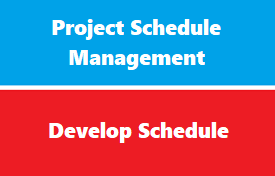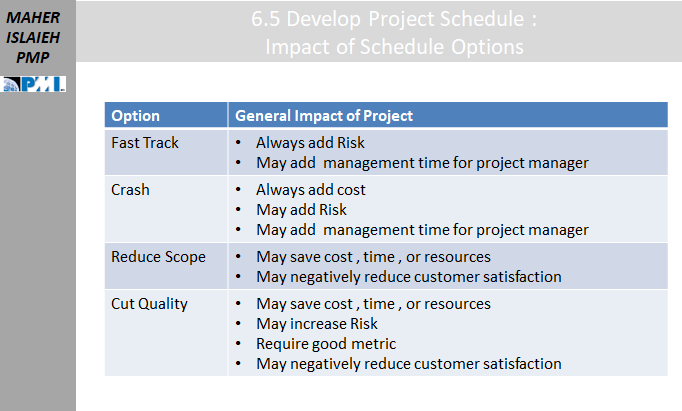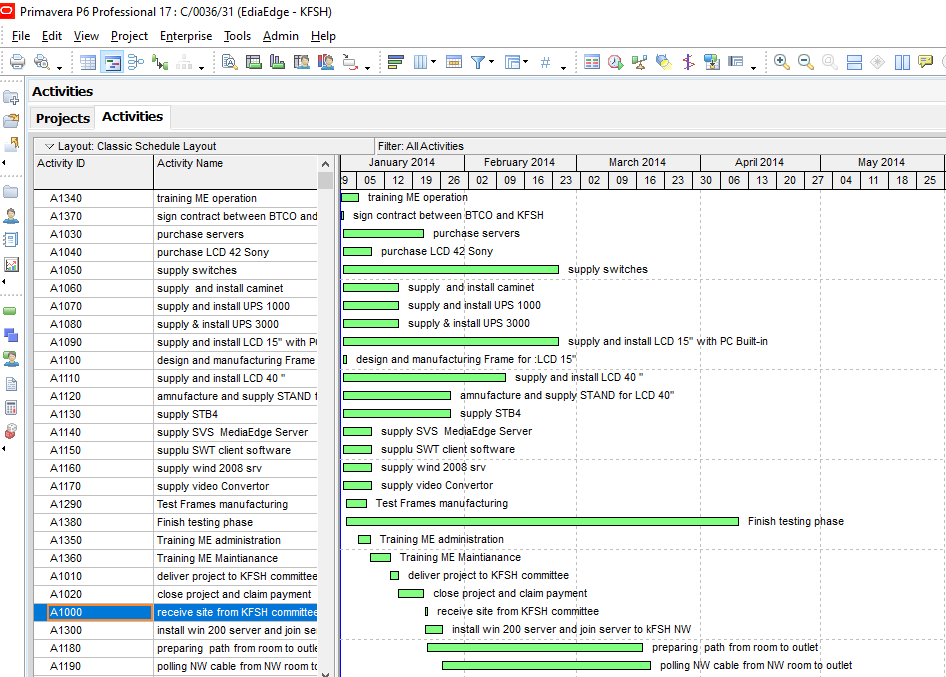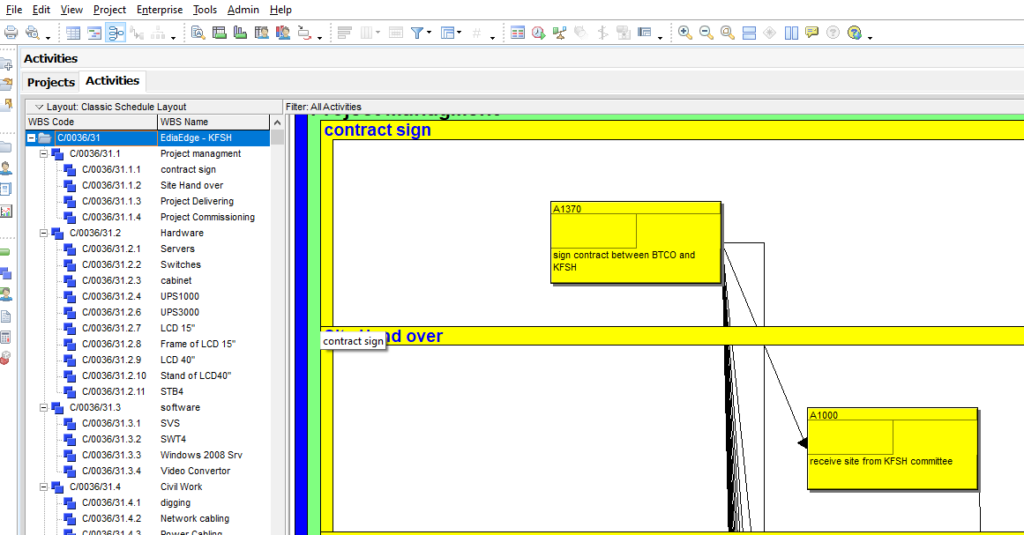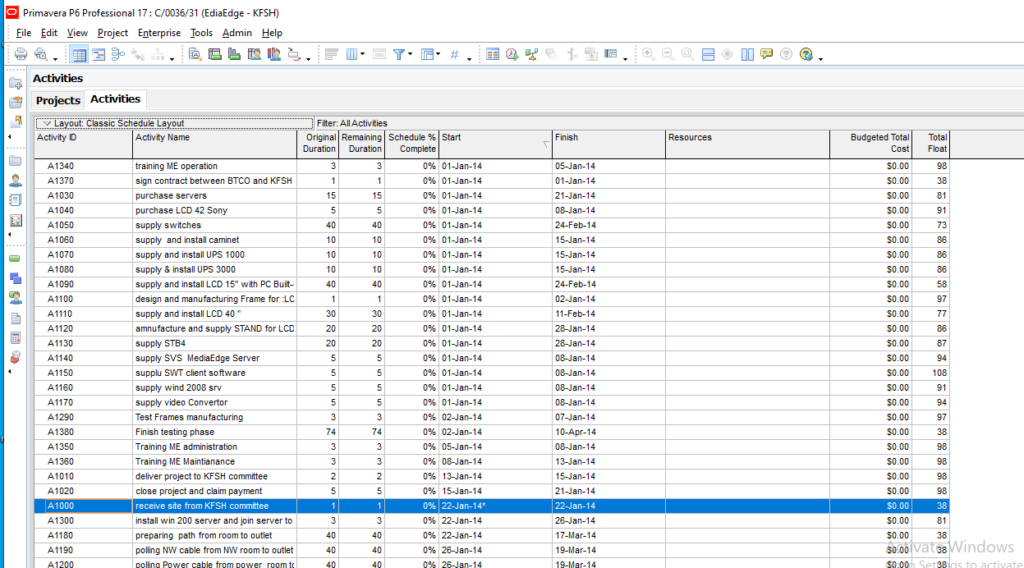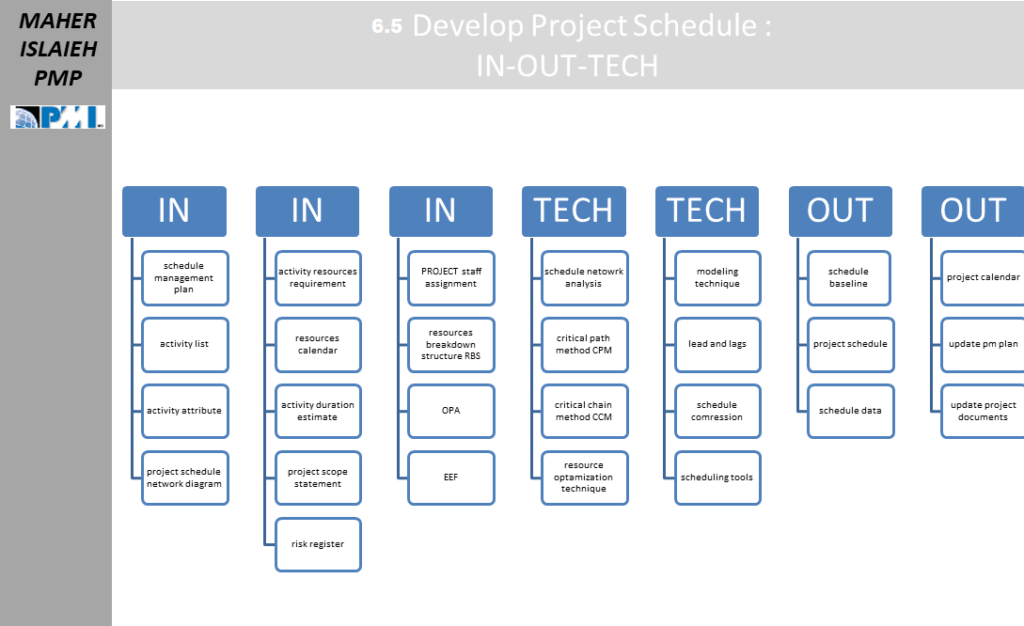introduction
Develop Schedule is the process of analyzing activity sequences, durations, resource requirements, and schedule constraints to create the project schedule model.
The key benefit of this process is that by entering schedule activities, durations, resources, resource availabilities, and logical relationships into the scheduling tool, it generates a schedule model with planned dates for completing project activities
Create Initial Schedule
What is needed to create project schedule (primary or initial schedule )?
- defined activities (activities list )
- order of how work will be done (network diagram )
- the estimate duration for each activity (activity duration estimate)
- estimate of resources needed (activity resources estimate )
- understanding of resources availability (resources calendar )
- the required resources by category (resource breakdown structure RBS)
- company calendar identifying working and NON working days
- list of pre-assigned resources to project by management or even by contract (project staff assignment )
- list of all risk that impact project
Finalize Schedule
Tools needed to Finalize Schedule the we created in above step :
- Critical path method CPM
- schedule compressing
- Fast Tracking : doing activates (with optional dependencies ) in parallel
- Crashing Project : adding or adjusting resourcing to compress project schedule
- modeling : like MONTECARLO : which is computer software that used to simulate outcome of based on three point estimate (PERT)
- resource optimization: like
- resource leveling : used to produce schedule with limited resources available
- resource optimization resources are leveled only within limit of their float
- critical chain method : rarely used in modern project management approach
Critical Path Method CPM
Critical path is longest duration path through network diagram that determine shortest time available to complete project
project could have many critical path , which is could represent higher risk to project
near critical path :the close duration to critical path
float (slack ):project have three type of float :
- total float : the amount of time could be delayed without delay project end date
- free float : the amount of time that activity can be delayed without delay successor activity
- project float : the amount of time that project could be delayed without project end date required by customer or management (set in charter )
Presenting Schedule Methods
Milestone Chart
- show only major events
- good for reporting to TOP management
- NO line between activities
Bar chart
- NO line between activities
- good to presented to project team
- used to track progress
network diagram
- show lines (dependencies ) between activities
Schedule Baseline
Schedule Baseline :
- once schedule is approved , it will be a part of project baseline , which mean it will NOT be changed until to get approval from CCB through ICC process (integrated change control)
who should approve schedule :
- The customer does not need to approve the detailed project schedule, just the end date and any milestones they might impose.
- Assuming the project manager is meeting the project objectives and constraints, the sponsor’s approval of a detailed schedule is not as critical as the approval of functional managers.
- Getting functional managers to approve will also, indirectly get team members’ approval.
- When functional managers know what work each of their people is assigned, the timeframe, and whether their activities are on the critical path, resource problems are less frequent. Approval of the schedule by functional managers provides the most benefits.
develop project schedule : inputs-techniques -outputs
Inputs
- schedule management plan
- activity list
- activity attribute
- project schedule network diagram
- activity resources requirement
- resources calendar
- activity duration estimate
- project scope statement
- risk register
- PROJECT staff assignment
- resources breakdown structure RBS
- OPA
- EEF
Techniques
- schedule network analysis
- critical path method CPM
- critical chain method CCM
- resource optimization technique
- modeling technique
- lead and lags
- schedule compression
- scheduling tools
Outputs
- schedule baseline
- project schedule
- schedule data
- project calendar
- update pm plan
- update project documents
develop schedule inputs
Activity list.
- This has been a common input for the previous processes that have been mentioned above and will have already been factored in, however he is an input that is implicitly used.
Activity attributes.
- Again, this has been a common input to the above processes, but because it contains extra information such as the individuals or knowledge, skills and experience required, along with their availability, it is an important input in order to create a realistic and achievable schedule.
Project schedule network diagrams
- These were created in the sequence activities process and because this diagram shows the activity order, it is a key input here. Remember that the project schedule network diagram only shows the sequence and dependencies of the activities, but that the develop schedule process assigns start and finish dates to each activity.
Activity resource requirements.
- These were developed in the estimate activity resources process, and describe all human and non human resources that are required for each activity.
Resource calendars
- These are vital as they show where resources are available and may constrain the timing, sequencing and dependencies of various activities and helps develop schedule.
Activity duration estimates
- Another important input as the duration of each activity along with its dependencies will be used to develop the schedule.
Project scope statement.
- This was developed within the define scope process and is valuable because it contains assumptions and constraints for the project which will have a direct bearing on the activity schedule that is created here.
Enterprise Environmental Factors.
- This may include aspects such how much risk is acceptable, or any laws or regulations that have an impact of the schedule.
Organizational Process Assets.
- These may include aspects such as policies, procedures or guidelines, or lessons learned from previous similar projects.
